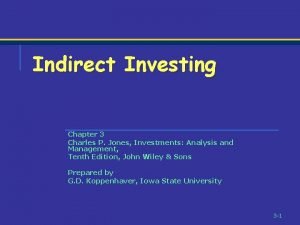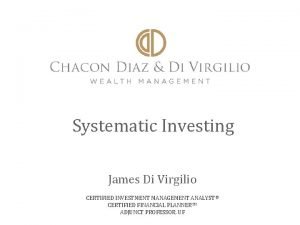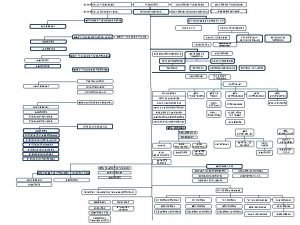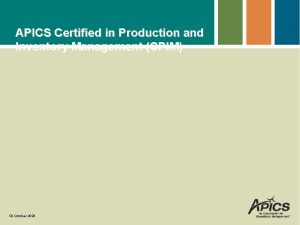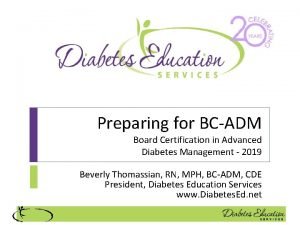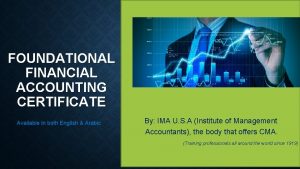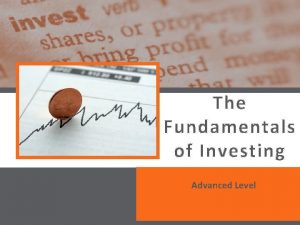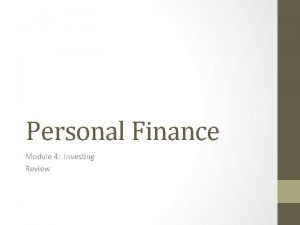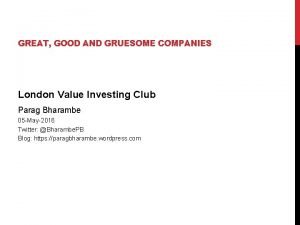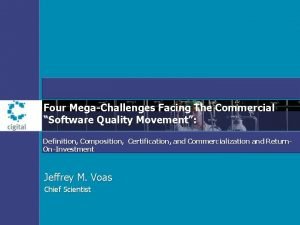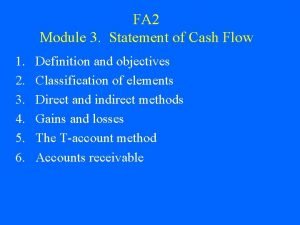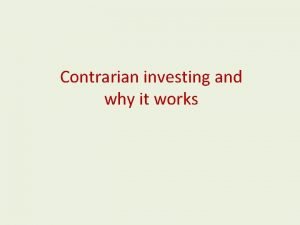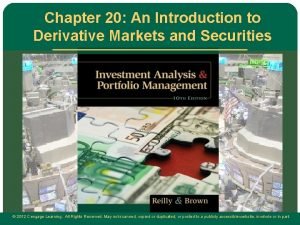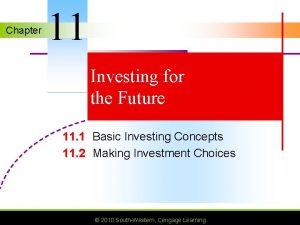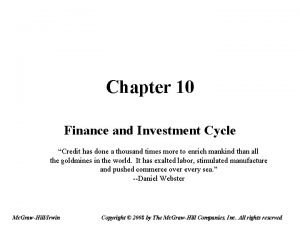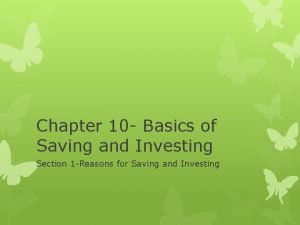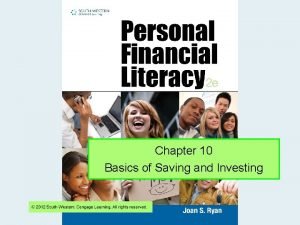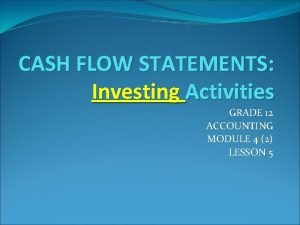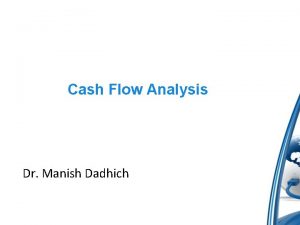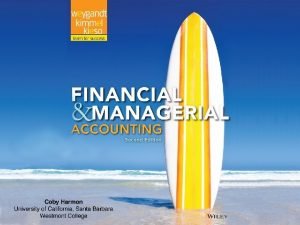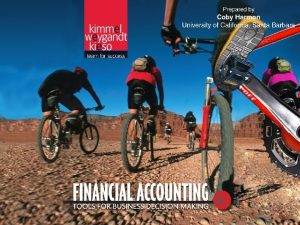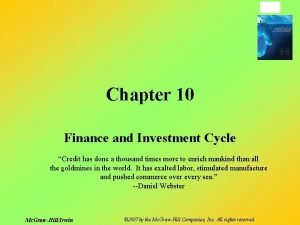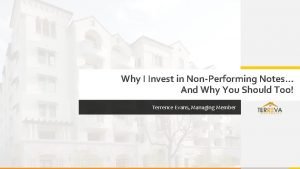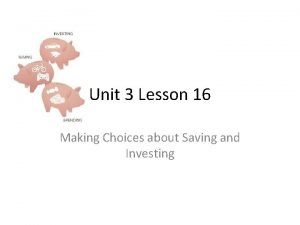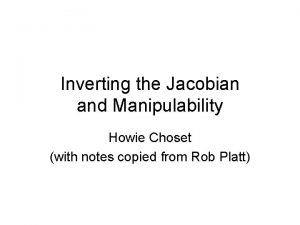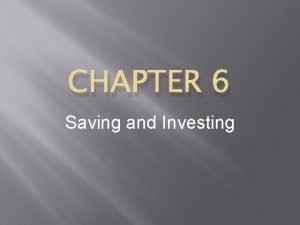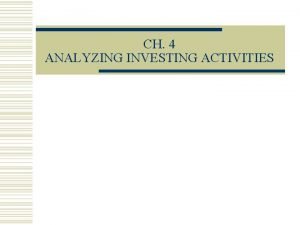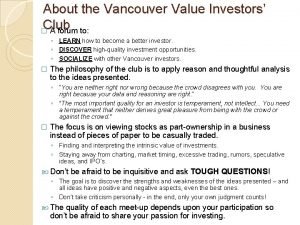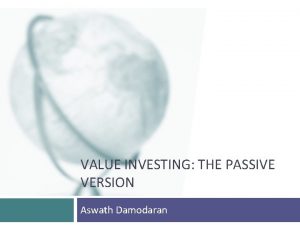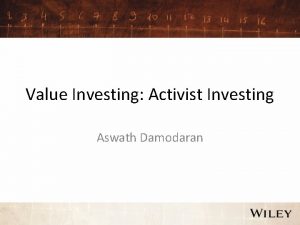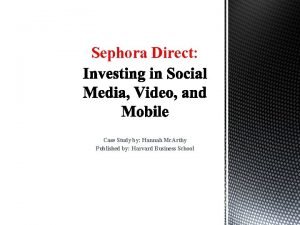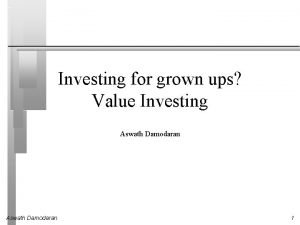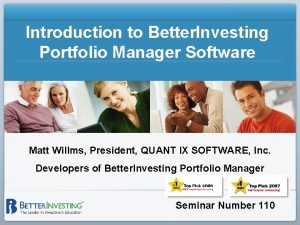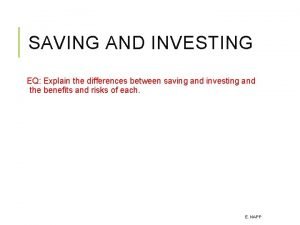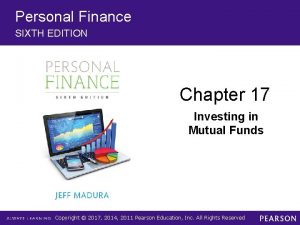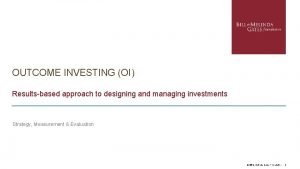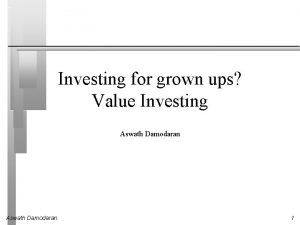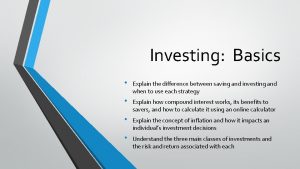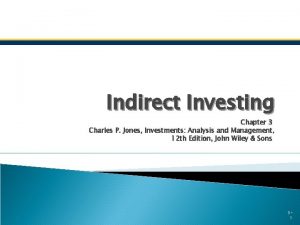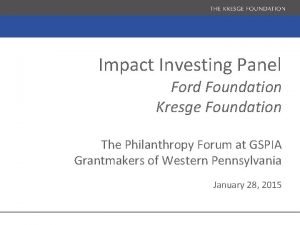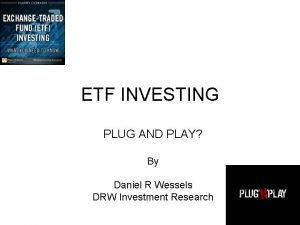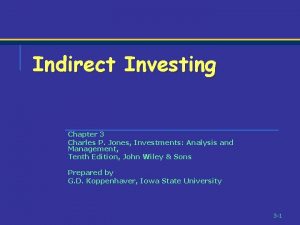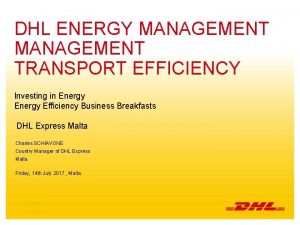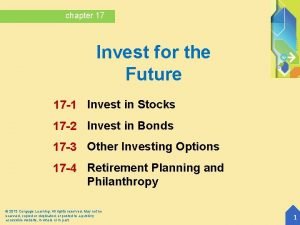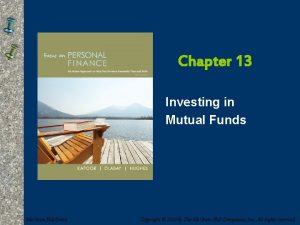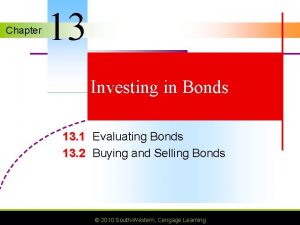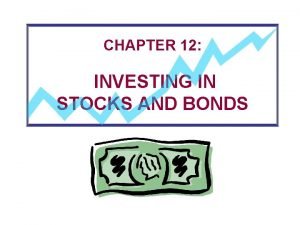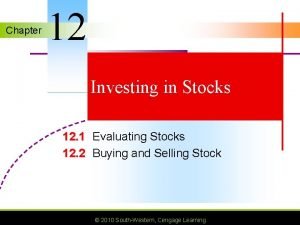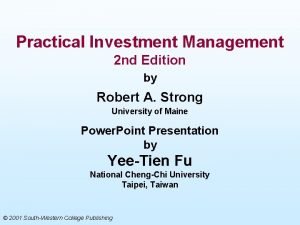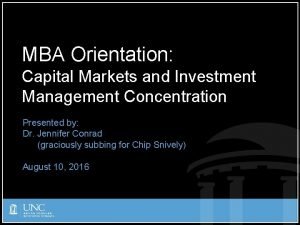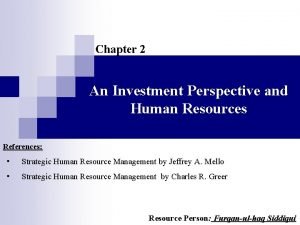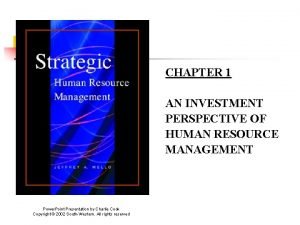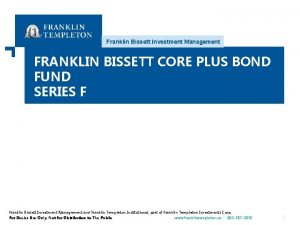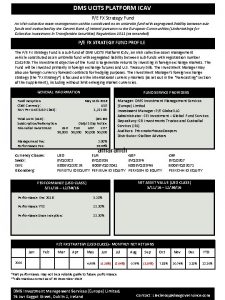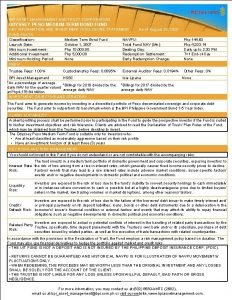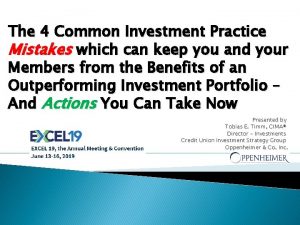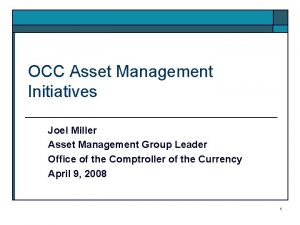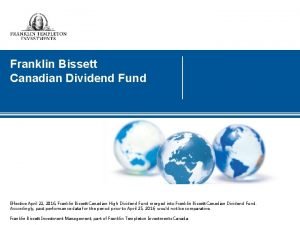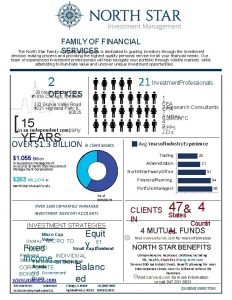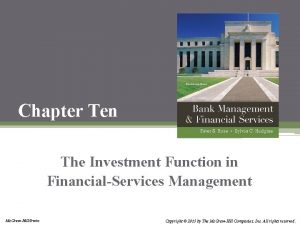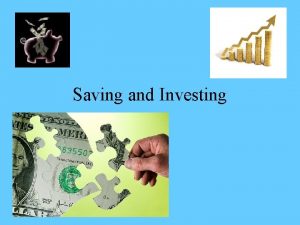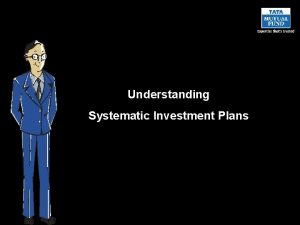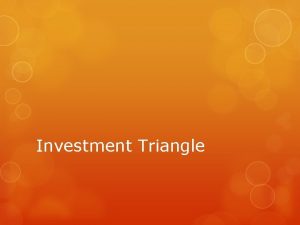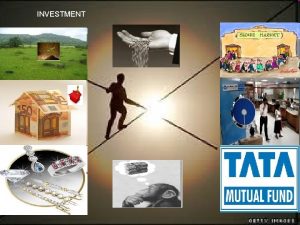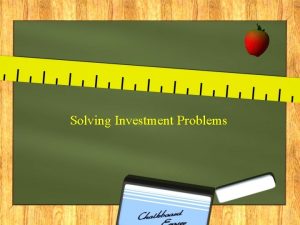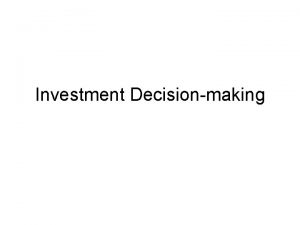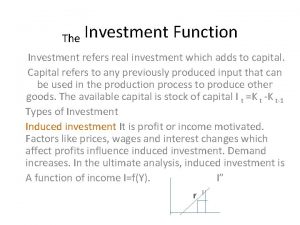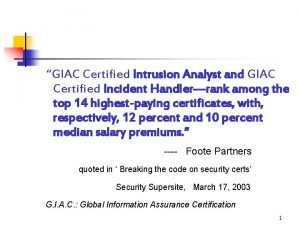Systematic Investing James Di Virgilio CERTIFIED INVESTMENT MANAGEMENT



















































































































- Slides: 115

Systematic Investing James Di Virgilio CERTIFIED INVESTMENT MANAGEMENT ANALYST ® CERTIFIED FINANCIAL PLANNERTM ADJUNCT PROFESSOR, UF

The Long Term- Real Returns

Buy and Hold an All Stock Portfolio

One Stock or Many? 1971 -2016 Diversification is better

The Downside to an All Stock Portfolio

Bear Market Performance Bear Markets Buy and Hold (S&P 500) Jan 73 -Sep 74 -42. 6 Dec 80 -Jul 82 -16. 5 Sep 87 -Nov 87 -29. 6 Sep 00 - Sep 02 -44. 7 Nov 07 - Feb 09 -50. 9 Average -36. 9 Source: Gary Antonacci

Flat Market Performance Flat Markets Buy and Hold (S&P 500) 1922 -1932 0. 4 1928 -1938 -1. 3 1964 -1974 0. 3 1999 -2009 0. 9 Average 0. 08 Source: Gary Antonacci

Buy and Hold a Stock and Bond Portfolio

Stocks and Bonds Together? Return Risk

Modern Portfolio Theory Return Risk

The “Efficient” Frontier Return Risk

Bonds Excel in Bear Markets Peak Trough May 1946 Oct. 1946 June 1948 June 1949 July 1957 Oct. 1957 Jan. 1962 June 1962 Feb. 1966 Oct. 1966 Nov. 1968 May 1970 Jan. 1973 Oct. 1974 Sept. 1976 Mar. 1978 Nov. 1980 Aug. 1982 July 1987 Dec. 1987 July 1990 Oct. 1990 July 1998 Aug. 1998 Mar. 2000 Oct. 2002 Oct. 2007 Mar. 2009 Apr. 2011 Oct. 2011 Averages S&P 500 -26. 6% -20. 7% -26. 4% -22. 2% -36. 1% -48. 2% -19. 4% -27. 1% -33. 5% -19. 9% -19. 3% -49. 1% -56. 8% -19. 4% -29. 7% 5 Year Treasuries 0. 4% 1. 6% 1. 4% 2. 5% 1. 3% 8. 6% 4. 0% 7. 6% 28. 8% -1. 8% 3. 0% 32. 7% 15. 0% 6. 1% 7. 5%

Correlation of Stocks and Bonds Correlation- Measuring the relationship between two things • Measured between -1 and 1. • Positive=both increasing or decreasing together • Negative=One is increasing and one is decreasing Stocks and Bonds are Negatively Correlated Overly Simplified Example Long Term Stock Average Return, 10% Long Term Bond Average Return, 5% If stocks are doing better than 10% during the year then…. It’s likely that bonds are doing worse than 5% that year.

60/40 Stock and Bond Diversification 1971 -2016 One Stock S&P 500 60/40 Compound Annual Growth Rate 10. 22 10. 4 9. 9 Annual Standard Deviation 31. 34 15. 2 10. 1 Sharpe Ratio 0. 19 0. 40 0. 44 Worst Drawdown -81. 7 -50. 9 -27. 3

Markowitz wins the Nobel prize

Buy and Hold a Multiple Asset Portfolio

Multiple Assets are better

Correlations of Other Assets

Multiple Asset Diversification 1971 -2016 One Stock S&P 500 60/40 MA Compound Annual Growth Rate 10. 22 10. 4 9. 9 11. 2 Annual Standard Deviation 31. 34 15. 2 10. 1 Sharpe Ratio 0. 19 0. 40 0. 44 0. 56 Worst Drawdown -81. 7 -50. 9 -27. 3 -23. 5

Human Behavior while Investing

Isaac Newton “An object at rest stays at rest and an object in motion stays in motion” Invested in the South Sea Company In 1720, Sold shares with 100% profit Then watched the price go higher, jumped back in and…

Newton goes broke

Madness “I can calculate the motion of heavenly bodies, but not the madness of people. ”

Revisiting Long Term- Real Returns

Investment Allocations MILLENNIALS Cash GENERATION X BABY BOOMERS SILENT GENERATION 70% 68% 60% 53% 14 17 20 22 Bonds 7 5 5 9 Real estate 4 3 3 4 2 1 1 3 8 8 Equities Alternatives Other Note: Silent generation, boomer and Gen X respondents with at least $100, 000 in household assets and millennial respondents with at least $50, 000 in household assets. Source: Black. Rock Global Investor Pulse

Average Investor Performance Average Annual Return 1985 -2015 12. 0% 7. 0% 10. 0% 6. 0% 10. 4% 6. 5% 5. 0% 8. 0% 6. 0% 1/3 rd of the 4. 0% return 3. 0% 3. 7% 2. 0% 1. 0% 0. 0% S&P 500 Individual Stock Investors 0. 0% Source: Dalbar 1/11 th of the return 0. 6% Barclays Agg Individual Bond Index Bond Investors

Herding • We prefer to follow the crowd We will deny logic to conform with others

Portfolio using Human Behavior

Momentum Investments that have performed better in the past year are more likely to perform better during the next year.

Buy and Hold vs. Momentum Since 1223 Source: Greyserman and Kaminski, Trend Following with Managed Futures, John Wiley & Sons, Inc, 2014

Three Types of Momentum • Relative Momentum, 1937 • Compare price performance of two assets over the past 12 months, choosing the asset that had performed better. • Absolute Momentum, 2012 • If the performance over the past 12 months is positive, stay in the asset. Otherwise, if the performance is negative, invest in risk-free assets. (Tbill) • Dual Momentum, 2015

Dual Momentum Index 12 Month Return Choice Relative Momentum S&P 500 Foreign Stocks 6% 12% Foreign Stocks Absolute Momentum Foreign Stocks US T Bills 12% 1% Foreign Stocks Index 12 Month Return Choice Relative Momentum S&P 500 Foreign Stocks -12% -15% S&P 500 Absolute Momentum S&P 500 US T Bills -12% 3% US Agg Bond

Dual Momentum Performance 1971 -2016 S&P 500 60/40 Multi-Asset Dual Mo Compound Annual Growth Rate 10. 4 9. 9 11. 2 16. 2 Annual Standard Deviation 15. 2 10. 1 12. 5 Sharpe Ratio 0. 40 0. 44 0. 56 0. 92 Worst Drawdown -50. 9 -27. 3 -23. 5 -17. 8 Source: Gary Antonacci

Dual Momentum Bull Market Performance Bull Markets Buy and Hold (S&P 500) Dual Mo Jan 71 -Dec 72 36. 0% 65. 6% Oct 74 -Nov 80 198. 3% 103. 3% Aug 82 -Aug 87 279. 7% 569. 2% Dec 87 -Aug 00 816. 6% 730. 5% Oct 02 - Oct 07 108. 3% 181. 6% Mar 09 -Jul 15 227. 7% 106. 4% Average 277. 7% 292. 7% Source: Gary Antonacci

Dual Momentum Bear Market Performance Bear Markets Buy and Hold (S&P 500) Dual Mo Jan 73 -Sep 74 -42. 6 15. 1 Dec 80 -Jul 82 -16. 5 16. 0 Sep 87 -Nov 87 -29. 6 -15. 1 Sep 00 - Sep 02 -44. 7 14. 9 Nov 07 - Feb 09 -50. 9 -13. 1 Average -36. 9 3. 6 Source: Gary Antonacci

Dual Momentum Bear Market Performance Source: Chacon Diaz & Di Virgilio

Dual Momentum Bear Market Performance Source: Chacon Diaz & Di Virgilio

Comparison of Strategies Growth of $1, 000 The Next 45 Years Average Investor $1, 091 Buy and Hold One stock $2, 583 Buy and Hold One Asset (S&P 500) $16, 745 Buy and Hold Two Assets (60/40) $17, 640 $31, 368 Buy and Hold Multiple Assets $483, 855 Dual Momentum $0 $100, 000 $200, 000 $300, 000 $400, 000 $500, 000

Overcoming Ourselves • Emotion causes us to abandon good strategies too early in favor of chasing what was best in the immediate past. • Combat human emotion by using a systematic and rules based strategy that has the best expected long term outcome. Trust it and stick with it during all seasons.

Investment Firms & Advisors Only 15% are Fiduciaries – A fiduciary acts all times for your sole benefit and interests, doing what’s best for you. Only 4% have Educational Designations that matter • CFA , Chartered Financial Analyst (2%) • CIMA ® , Certified Investment Management Analyst (2%) • There are lots of other designations, most of them are meaningless.

Questions? james@cddwealth. com

How we manage your portfolio

Portfolio Management We do all of the investing for you. As your fiduciary, we steadfastly and proactively manage your investments making changes whenever necessary, seeking to obtain the best possible result for you. We use only Exchange Traded Funds, (ETFs), because they are best type of investment for our strategy. When a change is made, we notify you. If no changes are made, we will email you at least monthly letting you know that your investments are unchanged. You are always able to reach out to us at any time, with any needs or questions that arise.

Portfolio Management Step 1 - Test Employ Dual Momentum to choose investments (Exchange Traded Funds) Over the Long Term Step 2 - Invest 100% US Stock ETFs or 100% US Bond ETFs or 100% Foreign Stock ETFs or A mixture Step 3 - Monitor Remain invested until DM trend suggests a change is necessary. (5 -10 times a year) 27% 45% 28% US Stocks US Bonds Foreign Stocks

Relative Momentum Index 12 Month Return Choice S&P 500 Foreign Stocks 12% 6% S&P 500 Index 12 Month Return Choice S&P 500 Foreign Stocks -18% -15% Foreign Stocks

Relative Momentum Performance 1971 -2016 S&P 500 60/40 Relative Mo Multi. Asset Compound Annual Growth Rate 10. 4 9. 9 13. 2 11. 2 Annual Standard Deviation 15. 2 10. 1 15. 9 10. 1 Sharpe Ratio 0. 40 0. 44 0. 56 Worst Drawdown -50. 9 -27. 3 -54. 6 -23. 5 Source: Gary Antonacci

Absolute Momentum Test Absolute Momentum Index 12 Month Return Choice S&P 500 US T Bills 12% 1% S&P 500 Index 12 Month Return Choice S&P 500 US T Bills -12% 3% US Agg Bond

Absolute Momentum Performance 1971 -2016 S&P 500 60/40 Relative Mo Multi. Asset Absolute Mo Compound Annual Growth Rate 10. 4 9. 9 13. 2 11. 2 12. 6 Annual Standard Deviation 15. 2 10. 1 15. 9 10. 1 11. 9 Sharpe Ratio 0. 40 0. 44 0. 56 0. 66 Worst Drawdown -50. 9 -27. 3 -54. 6 -23. 5 -29. 6 Source: Gary Antonacci

Testing Human Behavior Does the past matter? If a fairly weighted coin lands on heads 9 times in a row, what are the odds it lands on heads next time? A coin flip’s past history (trend) has no influence of its future. It provides no helpful information. We can apply the same test to human behavior and investing.

Testing Human Behavior In 1937 a Landmark study looked at two different investments and compared their price performance over the past 12 months, simply choosing the investment that had performed better. . .

Market Cycles

Our reaction to news • Overreact in the short term (less than one month) • Underreact in the medium term (3 -12 months) • Overreact in the long term. (12 months+)

Relative Momentum Performance 1971 -2016 S&P 500 60/40 Relative Mo Multi. Asset Compound Annual Growth Rate 10. 4 9. 9 13. 2 11. 2 Annual Standard Deviation 15. 2 10. 1 15. 9 10. 1 Sharpe Ratio 0. 40 0. 44 0. 56 Worst Drawdown -50. 9 -27. 3 -54. 6 -23. 5 Source: Gary Antonacci

Second Type of Momentum Observed • Absolute Momentum 2012 • If the performance over the past 12 months is positive, stay in the asset. Otherwise, if the performance is negative, invest in risk-free assets. (Tbill)

Absolute Momentum Performance 1971 -2016 S&P 500 60/40 Relative Mo Multi. Asset Absolute Mo Compound Annual Growth Rate 10. 4 9. 9 13. 2 11. 2 12. 6 Annual Standard Deviation 15. 2 10. 1 15. 9 10. 1 11. 9 Sharpe Ratio 0. 40 0. 44 0. 56 0. 66 Worst Drawdown -50. 9 -27. 3 -54. 6 -23. 5 -29. 6 Source: Gary Antonacci

Combining Relative and Absolute Momentum, creating Dual Momentum

Dual Momentum Performance 1971 -2016 S&P 500 60/40 Multi-Asset Dual Mo Compound Annual Growth Rate 10. 4 9. 9 11. 2 16. 2 Annual Standard Deviation 15. 2 10. 1 12. 5 Sharpe Ratio 0. 40 0. 44 0. 56 0. 92 Worst Drawdown -50. 9 -27. 3 -23. 5 -17. 8 Source: Gary Antonacci

Dual Momentum Bull & Bear Market Performance Bull Markets Buy and Hold (S&P 500) Dual Mo Jan 71 -Dec 72 36. 0% 65. 6% Oct 74 -Nov 80 198. 3% 103. 3% Aug 82 -Aug 87 279. 7% 569. 2% Dec 87 -Aug 00 816. 6% Buy and Hold (S&P 500) Dual Mo Jan 73 -Sep 74 -42. 6 15. 1 Dec 80 -Jul 82 -16. 5 16. 0 Sep 87 -Nov 87 -29. 6 -15. 1 Sep 00 - Sep 02 -44. 7 14. 9 Nov 07 - Feb 09 -50. 9 -13. 1 Average -36. 9 3. 6 730. 5% Oct 02 - Oct 07 108. 3% 181. 6% Mar 09 -Jul 15 227. 7% 106. 4% Average 277. 7% 292. 7% Source: Gary Antonacci Bear Markets

Growth of $1, 000 The Next 45 Years Average Investor $1, 091 Buy and Hold One stock $2, 583 Buy and Hold One Asset (S&P 500) $16, 745 Buy and Hold Two Assets (60/40) $17, 640 $31, 368 Buy and Hold Multiple Assets $483, 855 Dual Momentum $0 $100, 000 $200, 000 $300, 000 $400, 000 $500, 000

Why Dual Momentum? • Building a portfolio using dual momentum will best address risk and give us the greatest probability of success. It utilizes diversification, correlation, and human behavior. • Use trend following to responsively invest in stocks when they are strong, and when stocks are weak, invest in bonds. You don’t have to continually invest in unattractive asset classes in order to reduce your risk. • Non- Emotional- It’s systematic and rules based, no emotion is involved.

How we build your portfolio

Portfolio Management Step 1 - Test Employ Dual Momentum to choose investments Over the Long Term Step 2 - Invest 100% US Stock ETF or 100% US Bond ETF or 100% Foreign Stock ETF or A mixture Step 3 - Monitor Remain invested until DM trend suggests a change is necessary. (5 -10 times a year) 27% 45% 28% US Stocks US Bonds Foreign Stocks

Investment Firms & Advisors Only 15% are Fiduciaries – A fiduciary acts all times for your sole benefit and interests, doing what’s best for you. Only 4% have Educational Designations that matter • CFA , Chartered Financial Analyst (2%) • CIMA ® , Certified Investment Management Analyst (2%) • There are lots of other designations, most of them are meaningless.

Overcoming Ourselves • Emotion causes us to abandon good strategies too early in favor of chasing what was best in the immediate past. • Combat human emotion by using a systematic and rules based strategy that has the best expected long term outcome. Trust it and stick with it during all seasons.

Investment Returns and Your Future Start at 30, Save $10 k a year, retire at age 65, withdraw $40 k annually, live to 95. Money at Retirement, Age 65 Money at 95 Cash $218 k $0 5% $490 k $0 8% $864 k $0 9% $1 mil $1. 1 mil 10% $1. 3 mil $3. 9 mil 12% $1. 9 mil $16 mil

Using the Strategies • Buy and Hold One Asset – US S&P 500 ETF (VOO) • 60/40 (Target Date Funds in retirement accounts) – 60% in US S&P 500 ETF (VOO), 40% in US Bond ETF (AGG) • Multi Asset – 25% in US, 25% in Foreign, 25% in Real Estate, 25% in US Bonds • Dual Momentum – Rotate between stocks and bonds, use US S&P 500 ETF (VOO), Foreign ETF (CWI), US Bond ETF (AGG). Stay away from investing in individual stocks, using your emotions, day trading, or attempting to predict the market.

Dual Momentum Performance 1971 -2016 Growth Conservative Growth Capital Preservation Compound Annual Growth Rate 16. 2 14. 7 12. 2 Annual Standard Deviation 12. 5 8. 6 6. 5 Sharpe Ratio 0. 92 1. 13 1. 17 Worst Drawdown -17. 8 -11. 6 -7. 9 Source: Gary Antonacci

Using the Strategies • Buy and Hold One Asset – US S&P 500 ETF (VOO) • 60/40 (Target Date Funds in retirement accounts) – 60% in US S&P 500 ETF (VOO), 40% in US Bond ETF (AGG) • Multi Asset – 25% in US, 25% in Foreign, 25% in Real Estate, 25% in US Bonds • Dual Momentum – Rotate between stocks and bonds, use US S&P 500 ETF (VOO), Foreign ETF (CWI), US Bond ETF (AGG). Stay away from investing in individual stocks, using your emotions, day trading, or attempting to predict the market.

Performance After Taxes 1971 -2016 Before Taxes S&P 500 60/40 Multi-Asset Dual Mo Compound Annual Growth Rate 10. 4 9. 9 11. 2 16. 2 Annual Standard Deviation 15. 2 10. 1 12. 5 Sharpe Ratio 0. 40 0. 44 0. 56 0. 92 Worst Drawdown -50. 9 -27. 3 -23. 5 -17. 8 1971 -2016 After Taxes S&P 500 60/40 Multi-Asset Dual Mo Compound Annual Growth Rate 10. 0 9. 3 10. 4 14. 0 Annual Standard Deviation 15. 2 10. 1 12. 5 Sharpe Ratio 0. 38 0. 43 0. 53 0. 73 Worst Drawdown -50. 9 -27. 3 -23. 5 -17. 8

Efficient Market Hypothesis It contends that past price data (people) has no relationship with the future direction of security prices. It is impossible to "beat the market“, thus it is pointless to do anything other than own an index. -Eugene Fama 2013 Nobel laureate

Efficient Market Hypothesis “The efficient market Hypothesis represents one of the most remarkable errors in the history of economic thought. ” -Robert Shiller 2013 Nobel laureate

Combining Relative and Absolute Momentum

Dual Momentum Performance 1971 -2016 S&P 500 60/40 Relative Mo Multi. Asset Absolute Mo Dual Mo Compound Annual Growth Rate 10. 4 9. 9 13. 2 11. 2 12. 6 16. 2 Annual Standard Deviation 15. 2 10. 1 15. 9 10. 1 11. 9 12. 5 Sharpe Ratio 0. 40 0. 44 0. 56 0. 66 0. 92 Worst Drawdown -50. 9 -27. 3 -54. 6 -23. 5 -29. 6 -17. 8 Source: Gary Antonacci

Tail Risk- S&P vs Dual Mo

Relative and Absolute Momentum Since 1927 Relative Momentum Absolute Momentum Value Investing Source: D’Souza et al.

Dual Momentum Since 1927 Dual Momentum Source: D’Souza et al.

401 k vs. ROTH 401 k Joe and Jane, Married Filing Jointly Net Result Starting Value at Retirement Actual Tax Paid End Result Traditional 401 k $10, 000 $160, 000 $27, 000 $133, 000 Roth 401 k $7, 800 $125, 000 $2, 200 $125, 000 Traditional 401 k Net Benefit vs Roth 401 k +8, 000

401 k vs. ROTH 401 k Joe and Jane, Married Filing Jointly Net Result Starting Value at Retirement Actual Tax Paid End Result Traditional 401 k $10, 000 $160, 000 $35, 000 $125, 000 Roth 401 k $7, 800 $125, 000 $2, 200 $125, 000 Traditional 401 k Net Benefit vs Roth 401 k +0

401 k vs. ROTH 401 k Joe and Jane, Married Filing Jointly 100 k Taxable Income During Working and Retirement Years Working Year Contribution (Marginal Rate) Retirement Distribution (Effective Rate) Actual Tax Paid Traditional 401 k 22% tax avoided 14% tax paid 14% Roth 401 k 22% tax paid 13% tax avoided 22% Traditional 401 k Net Benefit vs Roth 401 k 8% The Roth 401 k won’t break even with the Traditional 401 k until Joe and Jane take close to $300, 000 of annual income in retirement. Conclusion: If youare single and makemore than $40 k AGI, or married and make more than $80 k AGI, choose the Traditional 401 k.

401 k vs. ROTH 401 k Joe and Jane, Married Filing Jointly 400 k+ Taxable Income During Working and Retirement Years Working Year Contribution (Marginal Rate) Retirement Distribution (Effective Rate) Actual Tax Paid Traditional 401 k 35% tax avoided 22% tax paid 22% Roth 401 k 35% tax paid 21% tax avoided 35% Traditional 401 k Net Benefit vs Roth 401 k 13% Conclusion: If youare single and makemore than $40 k AGI, or married and make more than $80 k AGI, choose the Traditional 401 k.

What we have learned thus far

Growth of $1, 000 The Next 45 Years $1, 091 Average Investor Buy and Hold One stock $2, 583 Market Timing and Frequently Trading $2, 825 Market Timing or Frequently Trading $6, 808 Buy and Hold One Asset (S&P 500) $16, 745 Buy and Hold Two Assets 60/40 Stocks and Bonds $17, 640 $31, 368 Buy and Hold Multiple Assets $0 $10, 000 $20, 000 $30, 000 $40, 000 $50, 000 $60, 000 $70, 000

How we think • "A bat and ball cost $1. 10. The bat costs $1 more than the ball. How much does the ball cost? “ • When we face an uncertain situation, we don't carefully evaluate the information or look up relevant statistics. Instead, our decisions depend on mental short cuts, which often us to making foolish decisions. This is regardless of IQ.

The Long Term- Real Returns

Investment Allocations MILLENNIALS Cash GENERATION X BABY BOOMERS SILENT GENERATION 70% 68% 60% 53% 14 17 20 22 Bonds 7 5 5 9 Real estate 4 3 3 4 2 1 1 3 8 8 Equities Alternatives Other Note: Silent generation, boomer and Gen X respondents with at least $100, 000 in household assets and millennial respondents with at least $50, 000 in household assets. Source: Black. Rock Global Investor Pulse

Average Investor Performance Average Annual Return 1985 -2015 12. 0% 7. 0% 10. 0% 6. 0% 10. 4% 6. 5% 5. 0% 8. 0% 6. 0% 1/3 rd of the 4. 0% return 3. 0% 3. 7% 2. 0% 1. 0% 0. 0% S&P 500 Individual Stock Investors 0. 0% Source: Dalbar 1/11 th of the return 0. 6% Barclays Agg Individual Bond Index Bond Investors

Predictive Market Timing? Percent Annual Return 12 Dollar-Weighted Return Buy-and-hold return 10 8 6 4 2 0 All Funds Growth Funds Value Funds Small-Cap Funds Large-Cap Funds S&P 500 Index Source: Jason Hsu, Brad Myers, Ryan Whitby, “Timing Poorly, A guide to generating Poor Returns While Investing in Successful Strategies. ” Journal of Portfolio Management, (Winter 2016).

Frequently Trading? Percent Annual Return 25 Monthly Turnover and Annual Performance of Individual Investors 20 15 Net Return Turnover 10 5 0 1 (Low Turnover) 2 3 4 5 (High Turnover) Source: Trading is Hazardous to Your Wealth, Barber and Odean, 2000, Journal of Finance

Buy and Hold One Asset Portfolio

One Stock or Many? 1971 -2016 Diversification is better

Bear Market Performance Bear Markets Buy and Hold (S&P 500) Jan 73 -Sep 74 -42. 6 Dec 80 -Jul 82 -16. 5 Sep 87 -Nov 87 -29. 6 Sep 00 - Sep 02 -44. 7 Nov 07 - Feb 09 -50. 9 Average -36. 9 Source: Gary Antonacci

Flat Market Performance Flat Markets Buy and Hold (S&P 500) 1922 -1932 0. 4 1928 -1938 -1. 3 1964 -1974 0. 3 1999 -2009 0. 9 Average 0. 08 Source: Gary Antonacci

Stocks or Bonds? (Short Term) Barclays US Aggregate Bond Index compared to S&P 500 1 -1 -1999 to 7 -31 -2015

Buy and Hold Two Asset Portfolio

Correlation of Stocks and Bonds Correlation- Measuring the relationship between two things • Measured between -1 and 1. • Positive=both increasing or decreasing together • Negative=One is increasing and one is decreasing Stocks and Bonds are Negatively Correlated Overly Simplified Example Long Term Stock Average Return, 10% Long Term Bond Average Return, 5% If stocks are doing better than 10% during the year then…. It’s likely that bonds are doing worse than 5% that year.

Stocks and Bonds are Different The total return of stocks and the total return of bonds have been negative together only 3 times in the past 120 years. Not one time since 1969.

Bonds Excel in Bear Markets Peak Trough May 1946 Oct. 1946 June 1948 June 1949 July 1957 Oct. 1957 Jan. 1962 June 1962 Feb. 1966 Oct. 1966 Nov. 1968 May 1970 Jan. 1973 Oct. 1974 Sept. 1976 Mar. 1978 Nov. 1980 Aug. 1982 July 1987 Dec. 1987 July 1990 Oct. 1990 July 1998 Aug. 1998 Mar. 2000 Oct. 2002 Oct. 2007 Mar. 2009 Apr. 2011 Oct. 2011 Averages S&P 500 -26. 6% -20. 7% -26. 4% -22. 2% -36. 1% -48. 2% -19. 4% -27. 1% -33. 5% -19. 9% -19. 3% -49. 1% -56. 8% -19. 4% -29. 7% 5 Year Treasuries 0. 4% 1. 6% 1. 4% 2. 5% 1. 3% 8. 6% 4. 0% 7. 6% 28. 8% -1. 8% 3. 0% 32. 7% 15. 0% 6. 1% 7. 5%

60/40 Stock and Bond Diversification 1971 -2016 S&P 500 60/40 Compound Annual Growth Rate 10. 4 9. 9 Annual Standard Deviation 15. 2 10. 1 Sharpe Ratio 0. 40 0. 44 Worst Drawdown -50. 9 -27. 3

Markowitz wins the Nobel prize

Buy and Hold Multiple Asset Portfolio

Multiple Assets are better

Correlations of Other Assets

Multiple Asset Diversification 1971 -2016 S&P 500 60/40 MA Compound Annual Growth Rate 10. 4 9. 9 11. 2 Annual Standard Deviation 15. 2 10. 1 Sharpe Ratio 0. 40 0. 44 0. 56 Worst Drawdown -50. 9 -27. 3 -23. 5

Trend Following Since 1223 Diversified Buy and Hold Portfolio Trend Following Average Return (annual) 4. 8% 13. 0% Std. Deviation (annual) 10. 3% 11. 2% 0. 47 1. 16 Sharpe Ratio Source: Greyserman and Kaminski, Trend Following with Managed Futures, John Wiley & Sons, Inc, 2014

Testing Human Behavior Does past performance (trend), which reflects how people feel about an investment, influence the future results?

Home Ownership as an Investment? James Di Virgilio CERTIFIED INVESTMENT MANAGEMENT ANALYST ® CERTIFIED FINANCIAL PLANNERTM ADJUNCT PROFESSOR, UF

History

The Real Returns on Housing Real rates of return include the leverage provided by mortgage financing and the expenses and benefits of owning a home.

The Real Returns on Housing 1802 -2016 Real Return What $1 invested becomes US Stocks 6. 6% $704, 997 US Bonds 3. 6% $1, 778 Gold 0. 7% $4. 52 US Dollar -1. 4% $0. 05 Residential Real Estate* 1975 -2016 -10. 8%* $0. 009*

The Long Term- Real Returns

Growth of $1, 000 The Next 45 Years Average Investor $1, 091 Buy and Hold One stock $2, 583 Buy and Hold One Asset (S&P 500) $16, 745 Buy and Hold Two Assets (60/40) $17, 640 $31, 368 Buy and Hold Multiple Assets $483, 855 Dual Momentum $0 $100, 000 $200, 000 $300, 000 $400, 000 $500, 000

Buying vs. Renting

Buying vs. Renting Buy vs. Rent- Net of All Costs/Benefits, Inflation, and Taxes 1 home- 15 yr Mortgage 1 home $0. 00 -$300, 000. 00 -$600, 000. 00 -$900, 000. 00 -$1, 200, 000. 00 Buy -$1, 500, 000. 00 Rent + Invest Down Payment 3 homes 6 homes

Buying a Home • Purchase Price (2. 5 x your gross income) – Make $120 k/yr, you can purchase a $300 k home • Down payment (≥ 20%) – Using the example above, $60 k should be the down payment • Be careful of the loan you choose – Generally, it’s wise to choose fixed over variable

Questions? james@cddwealth. com
 Indirect investing
Indirect investing James di virgilio
James di virgilio Fixed investment and inventory investment
Fixed investment and inventory investment Disorganized crime scene
Disorganized crime scene Russell odom and clay lawson
Russell odom and clay lawson Biografia di virgilio
Biografia di virgilio Biografia de virgilio
Biografia de virgilio Liceo linguistico mantova
Liceo linguistico mantova Scuola media virgilio cremona
Scuola media virgilio cremona Geolitica
Geolitica Ic borgo virgilio
Ic borgo virgilio Mastercom studenti crespi
Mastercom studenti crespi Xoomer virgilio
Xoomer virgilio Estructura de la divina comedia infierno
Estructura de la divina comedia infierno Virgiliotroia
Virgiliotroia Virgilio isaac hurtado cruz
Virgilio isaac hurtado cruz Virgilio matheus
Virgilio matheus Scuola media statale virgilio marone
Scuola media statale virgilio marone Meaning of norms
Meaning of norms Publio virgilio nasone
Publio virgilio nasone Virgilio autore
Virgilio autore José micard teixeira
José micard teixeira Virgilio levaggi
Virgilio levaggi Virgilio levaggi
Virgilio levaggi Cem designation
Cem designation Twic nexgen card
Twic nexgen card Certified in production and inventory management
Certified in production and inventory management Ipma c certification
Ipma c certification Bc-adm pass rate
Bc-adm pass rate Certified management accountant
Certified management accountant Operating activities vs investing activities
Operating activities vs investing activities Fundamentals of investment notes
Fundamentals of investment notes Personal finance module 4 test answers
Personal finance module 4 test answers Option investing strategies
Option investing strategies Lesson twelve saving and investing
Lesson twelve saving and investing Value investing damodaran
Value investing damodaran Great good gruesome
Great good gruesome Future smart smart shopping
Future smart smart shopping Investing in megachallenges
Investing in megachallenges Investing activities meaning
Investing activities meaning Define contrarian investing
Define contrarian investing Derivative in investing
Derivative in investing The spreading of risk among many types of investments.
The spreading of risk among many types of investments. Financing and investing cycle
Financing and investing cycle Chapter 10 basics of saving and investing
Chapter 10 basics of saving and investing Chapter 10 basics of saving and investing
Chapter 10 basics of saving and investing Grade 12 income statement format
Grade 12 income statement format Investing activities meaning
Investing activities meaning Purchase of a building cash flow statement
Purchase of a building cash flow statement Tax payable in cash flow statement
Tax payable in cash flow statement Operating activities
Operating activities Value investing meetup
Value investing meetup Finance and investment cycle
Finance and investment cycle Non performing note
Non performing note Guided reading activity 6 1 why save economics answers
Guided reading activity 6 1 why save economics answers Jacobian velocity
Jacobian velocity Chapter 6 saving and investing
Chapter 6 saving and investing Chapter 4 analyzing investing activities solutions
Chapter 4 analyzing investing activities solutions Valueinvestors club
Valueinvestors club Aswath damodaran value investing
Aswath damodaran value investing Aswath damodaran portfolio
Aswath damodaran portfolio Activist value investing
Activist value investing Sephora direct investing in social media video and mobile
Sephora direct investing in social media video and mobile Aswath damodaran value investing
Aswath damodaran value investing Betterinvesting ssg
Betterinvesting ssg Active investing average return
Active investing average return Professional venture
Professional venture What are the 10 principles of investing
What are the 10 principles of investing Impact investing spectrum
Impact investing spectrum Similarities between saving and investing
Similarities between saving and investing Chapter 17 investing in stocks
Chapter 17 investing in stocks Outcome investing
Outcome investing Investing cotton
Investing cotton Global ag investing
Global ag investing Investing in skills jobsplus
Investing in skills jobsplus Damodaran
Damodaran Describe the difference between saving and investing.
Describe the difference between saving and investing. Indirect investing
Indirect investing Ford foundation impact investing
Ford foundation impact investing Investor swix
Investor swix #1 rule of investing
#1 rule of investing Deras investing forum
Deras investing forum What is indirect investing
What is indirect investing Dhl investing
Dhl investing Bdo investing energy in nodes
Bdo investing energy in nodes Chapter 17 investing in stocks
Chapter 17 investing in stocks Chapter 13 investing in mutual funds
Chapter 13 investing in mutual funds Chapter 13 investing in bonds
Chapter 13 investing in bonds Chapter 12 investing in stocks
Chapter 12 investing in stocks Chapter 12 investing in stocks
Chapter 12 investing in stocks Practical investment management
Practical investment management Mba investment management concentration
Mba investment management concentration Investment perspective of human resource management
Investment perspective of human resource management An investment perspective of human resource management
An investment perspective of human resource management Steps in portfolio analysis
Steps in portfolio analysis Investment management segment
Investment management segment Investment analysis and portfolio management notes for mba
Investment analysis and portfolio management notes for mba Franklin bissett core plus bond f
Franklin bissett core plus bond f Pe investments fx strategy
Pe investments fx strategy Bpi asset management and trust corporation
Bpi asset management and trust corporation Common errors in investment management
Common errors in investment management Scope of investment analysis and portfolio management
Scope of investment analysis and portfolio management Investment analysis & portfolio management
Investment analysis & portfolio management Investment analysis and portfolio management course
Investment analysis and portfolio management course Korea investment management
Korea investment management Occ investment management handbook
Occ investment management handbook Key risk indicators financial risk management
Key risk indicators financial risk management Bissett investment management
Bissett investment management Fiduciary investment risk management association
Fiduciary investment risk management association North star investment management corporation
North star investment management corporation The investment function in financial services management
The investment function in financial services management James o'brien management information system
James o'brien management information system Scientific management
Scientific management Management pyramid
Management pyramid Basic concepts of management
Basic concepts of management State government entities certified agreement 2015 qld
State government entities certified agreement 2015 qld
